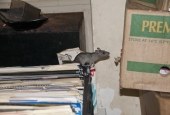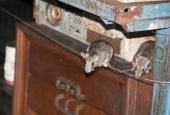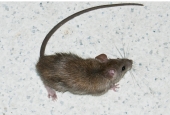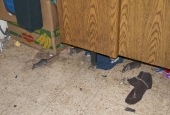The roof rat matures sexually at about 3 to 5 months and can produce two to six litters of 6 to 8 young per litter a year. They live for approximately a year.
Wooden snap traps are effective and can be purchased at most hardware stores. Traps can be baited with a variety of foods; peanut butter is the most popular because it is easy to use and attractive to mice and other rodents. There are a number of different types of traps on the market with varying methods of capture.
Proper trap placement is very important. Set traps along rodent runways and travel paths where you frequently see rodents or find droppings. For roof rats, especially, setting traps along fences or other above-ground routes of travel can be very successful. Select locations where roof rats might be coming down from their nests to find food, along overhead beams where they travel and attics that are close to the nest. Glue traps can be used but are less effective than snap traps. More traps often leads to greater success.
Structural modifications provide the most permanent and secure strategy for rodent proofing. Build a rat-proof structures for storing food, bird seed, and dog food in containers with tight-fitting lids. Seal all openings larger than ¼ inch to exclude both rats and mice. Repair all broken ventilation screens around the foundation and under the eaves. For roof rats, thinning dense vegetation, cutting down tree branches; removing overhanging tree limbs will make the environment less conducive to roof rat infestations. Call our District or submit an online request for an inspection and assessment if you would like assistance with a roof rat infestation in or around your home.
Download the complete Brochure here








